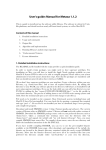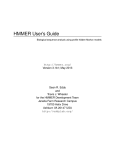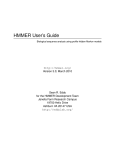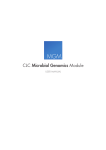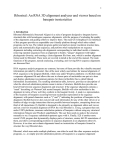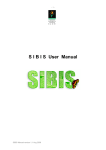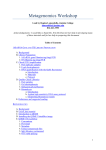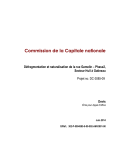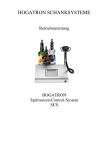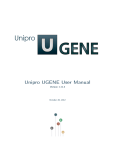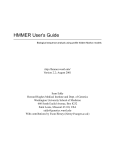Download Metaxa2 User's Guide - Microbiology, Metagenomics and
Transcript
User's guide: Manual for Metaxa2
This is a guide to install and use the software utility Metaxa2. The software is written for
Unix-like platforms, and should work on nearly all Linux-based systems, as well as MacOS X.
Contents of this manual
1. Detailed installation instructions
2. Changes from previous versions of Metaxa
3. Usage and commands
4. Output files
5. Metaxa2 Taxonomic Traversal Tool
6. Internal changes in Metaxa2
7. Running Metaxa2’s analysis steps separately
8. ‘Undocumented’ features
9. License information
1. Detailed installation instructions
The README.txt file bundled with the script provides a quick installation guide.
In order to install certain packages, you might need to have superuser privileges. For
installation on Mac, you will have to install the Apple Xcode package available on your
MacOS X System DVD in order to be able to compile programs. Please talk to your system
administrator if you feel unsure about these steps. Note that the packages are mandatory and
that you should not proceed unless these criteria are fulfilled.
[If you don’t have superuser privileges on your machine: Create a directory within your user
directory, e.g. /home/user/bin/, and to store all required binaries there. By adding this
directory to your PATH, any software placed in the directory will behave as if installed for all
users using superuser privileges. If you use the bash shell, you can add a bin directory to your
PATH, by adding the line “export PATH=$PATH:$HOME/bin/:.” to the file .profile in
your home directory. The process of adding items to one’s PATH varies among systems and
shells. Close the terminal and open a new one for this change to take effect.]
Perl needs to be installed on the computer. Most Unix-based systems including Linux and
MacOS X have Perl pre-installed. You can check this by opening a command line terminal
and type “perl -v”. In case Perl is not installed you have to download (http://www.perl.org)
and compile the program.
Download and install HMMER version 3 (http://hmmer.janelia.org/software). Version 2 of
Metaxa relies on HMMER version 3, just as the previous Metaxa versions. Metaxa2 will not
work with earlier versions of HMMER, although it will work with the HMMER 3.1 beta.
Download the HMMER package source code to your preferred directory such as
/home/user/. Open a command line terminal, move into the directory with “cd
/home/user/” and unpack the tarball with “tar -xvfz hmmer-3.0.tar.gz”. Now, you need to
compile HMMER from source files. To compile it from source, enter the new directory and
follow the installation instructions in the file INSTALL.
If you have trouble compiling HMMER, you can try to use the pre-compiled binaries
available at the HMMER home page. After download, and unpacking of the tarball, the
binaries are located in the binaries directory contained within the newly created HMMER
directory. Move into the binaries directory and move all of its contained files into your
preferred bin directory (usually either /usr/local/bin/ or your own bin directory,
/home/user/bin/). The HMMER package should now be installed on your computer; you
can check this by typing “hmmscan -h” in the terminal and press enter; you should now see
HMMER output.
Download and install the BLAST package (ftp://ftp.ncbi.nlm.nih.gov/blast/executables/
release/LATEST/) for sequence similarity searches. Metaxa2 works with both the legacy
version of BLAST, as well as BLAST+. It should work with any version of BLAST starting
with version 2.2 and better. Download the BLAST package for your operating system to your
preferred directory. Open a command line terminal, move into the directory with “cd
/home/user/” and unpack the tarball with “tar -xvfz blast-2.2.24-platform.tar.gz”. Move into
the bin directory inside the newly created BLAST directory, and move all of its contained files
into your preferred bin directory. Alternatively, you can add the BLAST bin directory to your
PATH. The BLAST package should now be installed on your computer; you can check this
by typing “blastall -” in the terminal and press enter; you should now see the listing of BLAST
options.
Download and install the MAFFT (http://mafft.cbrc.jp/alignment/software/) for multiple
alignment. Metaxa2, as previous versions of Metaxa, relies on MAFFT version 6. MAFFT is
not critical for Metaxa2’s core functions, but is used for automatically creating alignments of
uncertain sequences. Instructions for installing MAFFT are available on the MAFFT
download page.
Go to http://microbiology.se/software/metaxa2 in order to download the Metaxa2 package.
Download it to your preferred directory. Unpack the downloaded tarball with “tar -xvfz
metaxa2_2.0.tar.gz”. A directory called Metaxa2 will be created. You will see the following
files and directories inside it: metaxa2, metaxa2_x, metaxa2_c, metaxa2_ttt, install_metaxa2,
the metaxa2_db directory (containing the Hidden Markov Models and a BLAST database),
the user’s guide, the README.txt file, the license.txt file as well as test input files. Enter the
directory, and type “./install_metaxa2”. Press enter and follow the on-screen instructions.
You will be prompted for whether you have superuser privileges, and where you want
Metaxa2 to be installed. If Metaxa2 is successfully installed you should see its help message
when typing the command “metaxa2 --help”.
2. Changes from previous versions of Metaxa
Metaxa2 introduces a couple of new features over Metaxa 1.1.2, as well as changing the
default behaviour of some options. The main changes will be outlined below.
Extraction and classification of LSU rRNA sequences
One of the major new features in Metaxa2 is the addition of a second barcoding gene in
addition to the SSU gene; the large subunit rRNA (LSU), also known as 23S rRNA in
prokaryotes and 25S or 28S rRNA in eukaryotes. Toggling the switch from the SSU gene to
the LSU gene is done using the “-g lsu” or “--gene lsu” options (both set to “ssu” by default).
The operation of Metaxa2 is then the same as when searching for and extracting SSU genes.
Metaxa’s databases representing the SSU and LSU genes are kept separately within the
metaxa2_db directory. Although Metaxa2’s support for LSU extractions should be reliable
and robust, it has not been as extensively tested internally as the SSU extractions. Therefore,
we encourage users to report suspicious – or obviously misclassified – entries, so that Metaxa’s
LSU support can be improved even further in the future.
Completely redesigned system for taxonomic classifications
One of the design goals of Metaxa2 was to be able to make more sensible predictions of the
origin of each input sequence identified as an SSU or LSU gene, even at very short read
lengths. To achieve this, we have completely rewritten the classification engine, which has
enabled Metaxa2 to deliver reliable predictions of the taxonomic lineage of the extracted
SSU/LSU genes. Metaxa2 reports those lineages to a file with the suffix “.taxonomy.txt”. By
using the taxonomic data of the best five BLAST matches (by default), Metaxa2 calculates the
most accurate taxonomic placement possible for the input sequence, given the lineages of the
matching hits, and their degree of identity to the input sequence. Each entry is associated with
a lineage, and three numbers; the per cent identity to the best matching BLAST hit, the
length of that alignment, and a reliability score. The reliability score is calculated based on the
per cent identity to the best BLAST hit, and how divergent the rest of the BLAST hits are
from the first one. The maximum value of this score is 100. This score is only given if all five
BLAST matches are 100% identical to the input sequence, and all those matches represent
the same taxonomic lineage. This means that this situation rarely – if ever – occurs on real
data. Instead, scores above 80 should be considered trustworthy. The reliability score can
then be used to filter out uncertain entries when summarizing the taxonomic predictions with
the Metaxa2 Taxonomic Traversal Tool (metaxa2_ttt), described below.
The Metaxa2 Taxonomic Traversal Tool – metaxa2_ttt
Because of the extended abilities of Metaxa2 to classify SSU and LSU sequences more in
detail, a new tool to investigate the organismal content of the sample at different taxonomic
levels has been included in the Metaxa2 package. This tool is called the Metaxa2 Taxonomic
Traversal Tool, since it does exactly that – it traverses the “.taxonomy.txt” output file and
reports Metaxa’s taxonomic predictions according to specified cut offs. The complete usage of
the metaxa2_ttt tool is described in part five of this manual (Metaxa2 Taxonomic Traversal Tool).
In short, the traversal tool outputs the number of identified SSU/LSU sequences associated
with each node in the taxonomic tree, at different levels (roughly corresponding to kingdoms,
phyla, classes, orders, families, genera, species, subspecies, etc.)
The “--guess_species” option is now obsolete
Since Metaxa2 now handles taxonomy in a much more elaborate way, the “--guess_species”
option has been deemed obsolete. It is, however, still useful, but a warning message will
appear. The function may be depreciated in future versions of Metaxa, and is not actively
maintained anymore (and has thus not been tested in the Metaxa2 testing).
Updated database for classification
The improved classification engine has naturally required us to update and improve upon the
underlying databases. The basis of the Metaxa2 databases is the SILVA reference release 111
and Mitozoa release 10. From this data, we have created a curated reference database, in
large part by automated means, but also using extensive manual curation and cross-checking
in GreenGenes, CRW and GenBank. Suspicious or erroneous entries were removed, as well
as sequences from uncultured or unverified organisms.
Direct input of sequences in FASTQ-format
Metaxa2 now supports input of sequence data sets directly in the FASTQ format. Although
Metaxa2 will try to auto-detect the format of the input file, specifying “-f fastq” will force
Metaxa2 to read input in FASTQ format. This option might be particularly useful when
piping input to Metaxa2 using standard input. Note that FASTQ files are only supported
when Metaxa2 is run in pipeline mode, i.e. not when the two tools metaxa2_x and metaxa2_c
are run separately. These two tools still expect input in FASTA format.
Support for paired-end libraries
In addition, to FASTQ support, Metaxa2 also handles paried-end libraries. Paired-end data
needs to be supplied in two separate files, with sequence 1 in both files corresponding to the
two ends of the same read, and so on. If your data is held in a single file, a utility such as the
pefcon and pesort tools of the PETKit (http://microbiology.se/software/petkit/) can help
you. To enable Metaxa2’s paired-end capabilities, use the options “-1 firstfile -2 secondfile”
instead of the “-i” option for input. Metaxa2 will automatically orient the reads in the same
direction, and utilize a combination of the two ends for the extraction and classification
process. Note that the two ends will be outputted together as one single read with a spacer.
Improved support for libraries with short read lengths (~100 bp)
Since metagenomics is moving towards shorter read lengths and larger data sets (e.g. Illumina
and IonTorrent sequencing), special care has been taken to try to address the short-read issues
in previous Metaxa versions. We have tried to optimize the default options for reads down to
~100 bp, however, this will increase the likelihood of false positive extractions somewhat. This
should be kept in mind when using Metaxa2 on longer reads, which might require tweaking
of the default options (one may, for example, compare to the default options of Metaxa 1.1.2).
Quality pre-filtering of reads in FASTQ-format
Metaxa2 can use the quality information in the FASTQ files to filter out low-quality reads or
read pairs. This is controlled by a range of options described in part three of the manual
(Usage and Commands).
Support for the modern BLAST+ package
Metaxa2 now incorporates the long sought-after support for the NCBI BLAST+ package,
enabling users to move on to what is deemed the future of BLAST.
Compatibility with HMMER 3.1
Not only does Metaxa2 bring BLAST+ compatibility, it also secures support for the
upcoming version of HMMER (released in beta at the time of writing).
Changed default priority for scoring best HMMER match
As part of the optimization for larger data sets and shorter reads, Metaxa’s priority system for
determining the best HMMER match has now been changed from “sum” to “score”. To
switch back to Metaxa 1 behaviour, one can use the “--selection_priority sum” option. Be
aware of that this might influence other parameters as well!
HMMER’s heuristics are now used by default
Another optimization for larger data sets is that the heuristics of HMMER has now been
turned on by default. To switch the heuristics of, use the “--heuristics F” option. Note,
however, that this will make HMMER much slower on large data sets.
3. Usage and commands
For the very impatient only: follow the brief installation instructions in the file
README.txt. To check for SSU rRNA sequences in the file test.fasta, you would then type
“metaxa -i test.fasta -o test” on the command line. To check for LSU rRNA sequences, type
“metaxa -i test.fasta -o test -g lsu” instead.
For all other users: Metaxa2 accepts input in the FASTA and FASTQ formats. As it preprocesses the input sequences it is possible to input both aligned and unaligned FASTA files,
containing both DNA and RNA sequences. By default, Metaxa2 outputs ten files; one
summary file of the entire run, one “graphical” representation of hits, one FASTA file of all
identified SSU sequences, one FASTA file for each of the six possible origins, and one file
containing the predicted taxonomic origin of the extracted sequences. To list all the available
options for Metaxa2, type “metaxa2 --help”. You can use the test.fasta file that comes
bundled with the software for a test run. This file contains 50 randomly selected SSU entries,
ten of each origin, 50 randomly selected LSU entries, and 10 non-SSU, non-LSU sequences.
In the simplest case, Metaxa2 is run by “metaxa2 -i input_file -o output”. Below is a listing of
all options Metaxa2 accepts. Boolean options can be turned on with “T”, “true” or “1” and
off using “F”, “false” or “0”.
Main options:
-i {file}
Nucleotide FASTA/FASTQ input file to investigate. Metaxa2 accepts both
aligned and unaligned FASTA. If no input is specified, Metaxa2 will read
sequences from standard input, which means that FASTA sequences can
be piped into Metaxa2.
-o {file}
Base for the file names of the output files. Suffixes will be added
automatically. Defaults to metaxa_out.
-1 {file}
DNA FASTA/FASTQ input file containing the first reads in the read pairs
to investigate. Use instead of the -i option.
-2 {file}
DNA FASTA/FASTQ input file containing the second reads in the read
pairs to investigate. Use instead of the -i option, and only together with
the -1 option. Note that the reads in the files must be in the same order.
--pairfile {file}
As an alternative to using the -1 and -2 options, the user might use -i
and --pairfile instead, which has the same meaning.
-f {a, auto, f, fasta, q,
fastq, p, paired-end,
pa, paired-fasta}
Specifies the format of the input file(s). By default, Metaxa2 will try to
auto-detect the format (auto). Synonymous to “--format”.
-g {ssu, lsu}
Specifies if Metaxa2 should identify and extract SSU or LSU rRNA genes.
By default, Metaxa2 will look for SSU genes (ssu).
-p {directory}
A path to a directory containing HMM-profile collections representing
SSU rRNA conserved regions. By default, Metaxa assumes to find the
databases in the metaxa_db directory, located in the same directory as
Metaxa itself.
-d {database}
The BLAST database used for classification. By default, Metaxa assumes
to find the databases in the metaxa_db directory, located in the same
directory as Metaxa itself.
--date {T or F}
Adds a date and time stamp to the output file. This can be useful e.g. if
Metaxa is part of a pipeline where input files with the same name could
cause overwriting of important data. Off (F) by default.
--plus {T or F}
If enabled, the BLAST search will be performed using BLAST+ instead of
the legacy blastall engine. By default, blastall is used (F).
FASTQ and Paired-end specific options:
Note that FASTQ format is only supported when Metaxa2 is run in pipeline mode.
-q {value}
Minimum quality value for a nucleotide to be considered “good”.
Default = 20.
--quality_percent
{value}
Percentage of low-quality (below -q value) accepted before
filtering/trimming is started. Default=10.
--quality_filter {T or F}
If enabled, Metaxa2 will filter out low-quality reads (below specified -q
value), removing them entirely from the input data before running the
HMMER searches. Off (F) by default.
--quality_trim {T or F}
If enabled, Metaxa2 will trim bad bases (below -q value) from the end of
the read. This is generally to prefer over filtering the read entirely. Off (F)
by default.
--ignore_paired_read
{T or F}
When enabled, Metaxa2 will not discard the entire read pair if only one
of the reads is of bad quality and would be filtered out. On (T) by default.
--distance {value}
Specifies the distance between the sequence pairs (often referred to as
the insert size). Changing this value has little impact on Metaxa2’s actual
performance. Default = 150.
Sequence selection options:
-t {b, bacteria, a,
archaea, e, eukaryota,
m, mitochondrial, c,
chloroplast, A, all}
Set of profiles to use for the search (comma-separated). Accepts any list
of sets, e.g. “bacteria,chloroplast”, “m,c” or “eukaryota”. Can be used to
restrict the search to only a few SSU/LSU types to save time, if one or
more of the origins are not relevant to the dataset under study. Default
is to use all (the “all” option).
-E {value}
Domain E-value cutoff a sequence must obtain in the HMMER-based
step to be included in the output. Default = 1.
-S {value}
Domain score cutoff for a sequence must obtain in the HMMER-based
step to be included in the output. Default = 12.
-N {value}
The minimum number of domains that must match a sequence for it to
be included in the output. Setting the value lower than two will increase
the number of false positives, while increasing it above two will
decrease Metaxa’s detection abilities on fragmentary data. Default = 2.
-M {value}
Number of top BLAST matches that should be considered in
classification. This setting also affects the number of matches used for
taxonomic classification. Default = 5.
-R {value}
Reliability score cutoff for the taxonomic classification. Entries not
satisfying the cutoff will be classified at the level above in the taxonomic
hierarchy, until the reliability score is above the threshold. Default = 80.
-H {value}
The number of points that the predicted origin of the Metaxa Extractor
is given. Default is the same as the number of sequences used for
classification (-M option above), which is set to 5 by default.
--selection_priority
{score, sum, domains,
eval}
Determines what will be of highest priority when assessing the origin of
the sequence. Options are:
- score, which uses the average score of the found hits
- sum, which sums the scores for each profile match and divides the sum
by the number of profiles of the given type
- domains, which uses the number of domains retrieved of a given type
- eval, which uses the average E-value of the found hits
Default is to use score.
--search_eval {value}
The actual E-value cutoff used in the HMMER search. High numbers may
slow down the process. Should never be set to a lower value than the -E
option. Cannot be used in combination with the --search_score option.
Default is to use score cutoff (see --search_score below), not E-value.
--search_score {value}
The score cutoff used in the HMMER search. Low numbers may slow
down the process. Should never be set to a higher number than the -S
option. Cannot be used in combination with the --search_eval option.
Default = 0.
--blast_eval {value}
The E-value cutoff used in the BLAST search. High numbers may slow
down the process. Cannot be used in combination with the
--blast_score option. Default is 1e-15.
--blast_score {value}
The score cutoff used in the BLAST search. Low numbers may slow down
the process. Cannot be used in combination with the --blast_eval
option. Default is to use E-value cutoff (see --blast_eval above), not
score.
--blast_wordsize
{value}
The word-size used for the BLAST-based classification. Lower numbers
will slow down the process significantly, while higher numbers may
potentially decrease classification accuracy. Default is 14.
--allow_single_domain
{e-value,score or F}
Allow inclusion of sequences that only find a single domain, given that
they meet the more stringent E-value and score thresholds specified. By
default, single domains are allowed, with E-value cutoff 1e-10 and score
cutoff 0 (“1e-10,0”).
--allow_reorder {T or F}
Allows profiles not to be in the expected order (1-9) on the extracted
sequences. If turned off, a file of potential chimeric sequences (with
profile matches in the wrong order) is written, allowing for rudimentary
chimera detection. This can (and should) be used on full-length
sequences. On fragmented sequences, however, the risk of missing true
positives increases if this option is turned off. On (T) by default.
--complement {T or F}
If on, Metaxa2 checks both DNA strands for matches to HMM-profiles.
On (T) by default.
--cpu {value}
The number of CPU threads to use. Metaxa performs significantly faster
using more CPUs. Default is 1.
--multi_thread {T or F}
Multi-thread the HMMER-search. On (T) by default if the number of CPUs
is larger than one (--cpu option > 1), else off (F).
--heuristics {T or F}
Selects whether to use HMMER's heuristic filtering. On (T) by default.
Turning this setting off will decrease speed, but increase precision.
--megablast {T or F}
Uses megablast for classification for better speed but less accuracy. Off
(F) by default.
Output options:
--summary {T or F}
If on, Metaxa outputs a summary of results. File suffix is “.summary.txt”.
On (T) by default.
--graphical {T or F}
If on, Metaxa outputs “graphical” text representations of where in each
sequence the conserved domains were found. File suffix is “.graph”. On
(T) by default.
--fasta {T or F}
If on, FASTA-formatted files containing the extracted SSU sequences are
written. One file for each origin is written, plus an extraction file
containing all SSUs identified in the first analysis step. On (T) by default.
--table {T or F}
If on, Metaxa saves table format output of results, separately for HMMER
and BLAST output. Note that neither of these outputs is the actual
output of the respective program. To get these file, use the “--save_raw
T” (see below). Off (F) by default.
--taxonomy {T or F}
Table format output of probable taxonomic origins for the identified
SSU/LSU sequences. File suffix is “.taxonomy.txt”. On (T) by default.
--taxlevel {integer}
Forces Metaxa to classify sequences at a certain taxonomy level,
regardless of their reliability score. Off (0) by default.
--not_found {T or F}
If on, Metaxa outputs a list of entries that do not seem to be SSU
sequences. File suffix is “_not_found.txt”. Off (F) by default.
--align {a, all, u,
uncertain, n, none}
Outputs alignments of BLAST matches to each query in all (a), uncertain
(u) or no (n) cases. Requires MAFFT to be installed. Default is to output
alignments in uncertain cases (u).
--truncate {T or F}
Removes ends of SSU sequences if they are outside of the SSU region. If
off, the whole input sequence is saved. On (T) by default.
--guess_species {T or F}
Depreciated option, use the --taxonomy option instead. Kept for
compatibility with previous Metaxa versions. Off (F) by default.
--silent {T or F}
Suppresses printing of progress info to screen. Off (F) by default.
--graph_scale {value}
Sets the scale of the graphical output. If the provided value is zero, a
percentage view is shown. Default is 0.
--save_raw {T or F}
Saves all raw data for searches etc. instead of removing it when finished.
Saves data to a directory with the suffix “_metaxa_raw_output”. Off (F)
by default.
Information options:
-h
Displays basic usage help.
--help
Displays the help message, complete with all options.
--bugs
Displays the bug fixes and known bugs in this version of Metaxa.
--license
Displays licensing information.
4. Output files
Metaxa2 outputs a number of files, depending on what is selected by the user (see Usage and
Commands above). By default, seven FASTA-files, a table of taxonomic classifications, a file
containing graphical representation of putative SSU/LSU sequences, and a summary file is
written. In addition, tables of BLAST and HMMER results, lists of non-targeted entries, and
sequence alignments can be written on request by the user. There is also an option to preserve
all the intermediate data generated by the HMMER and BLAST searches.
FASTA-output
Metaxa2 generates one FASTA file for each origin (archaea, bacteria, eukaryota, chloroplast,
and mitochondria), one file containing sequences of uncertain origin, and one file with all
rRNA sequences identified and extracted in the first step. Sequences in these files are marked
according to their origin. Sequences whose origin Metaxa2 could not establish with certainty,
but for which enough data were available to allow a qualified guess as to the origin of the
sequences, are marked with a “#” character at the end of the definition line. A certain
sequence may look like this:
>gi|117927211 Bacterial 16S SSU rRNA
GTTTGATCCTGGCTCAGGACGAACGCTGGCGGCGTGCTTAACACATGCAAGTCGAGCGGA…
Note that Metaxa2 has added the type of the SSU sequence (“Bacterial 16S SSU rRNA”) to
the definition line in the example above. An uncertain sequence could look like this:
>AABL01000014.4508.5931 Putative Chloroplast 16S SSU rRNA #
GAACGCTAGAAATATACATTACACATGCAAATTTATGATAATATCATAGTGAATAGGTGA…
The extraction file contains all sequences identified as rRNA by metaxa2_x (the first step of
the analysis). The sequence entries in that file contain information on what domains that were
found and what origin that is most likely base on the profile search. An example is shown
below:
>A16379.1.1496|B Predicted Bacterial 16S SSU rRNA (1447 bp) From
domain V1l to V9r on main strand Found domains: V1l V2l V2r V3l V3r
V4l V4r V5l V5r V6l V7l V8l V8r V9l V9r
CAGGCTTAACACATGCAAGTCGAACGGTAGCACGAAGGACTTGCTCCTTGGGTGACGAGT…
Summary
A summary of the Metaxa2 run is written to a file with the suffix “.summary.txt”. In this file
the statistics of the run is collected, as are the starting and ending times for the run. Also, lists
of the identifiers of extracted SSU sequences are written to this file, one list for each origin.
The first section of the file shows the data from the extraction step. The second section is
associated with the second classification step. After the second section, the lists of entries of
different origins are found. An example of parts of a summary file is shown below:
Metaxa run started at Tue Jul 23 10:07:52 2013.
----------------------------------------------------------------Number of sequences in input file:
100
Sequences detected as SSU rRNA by Metaxa: 100
On main strand:
91
On complementary strand:
9
SSU sequences by preliminary origin:
Archaea:
0
Bacteria:
0
Eukaryota:
0
Chloroplast:
100
Mitochondria:
0
Other:
0
----------------------------------------------------------------Number of SSU rRNA sequences to be classified by Metaxa:
100
Number of SSU rRNA having at least one database match:
100
Number of SSU rRNA successfully classified by Metaxa:
100
Number of uncertain classifications of SSU rRNA sequences: 0
Total number of classifications made by Metaxa:
100
Number of SSU rRNA sequences assigned to each origin:
Archaea:
0
Bacteria:
0
Eukaryota:
0
Chloroplast:
100
Mitochondria:
0
Uncertain:
0
----------------------------------------------------------------Sequences of archaeal origin (16S):
----------------------------------------------------------------Sequences of bacterial origin (16S):
----------------------------------------------------------------Sequences of eukaryote origin (18S):
----------------------------------------------------------------Sequences of chloroplast origin (16S):
Acorus_americanus_AcamCr001
Aethionema_cordifolium_AecoCr001
...
Welwitschia_mirabilis_WemiC_r001
Zea_mays_ZemaCr113
----------------------------------------------------------------Sequences of mitochondrial origin (12S and 16S):
----------------------------------------------------------------Sequences of uncertain origin:
----------------------------------------------------------------Metaxa run finished at Tue Jul 14 10:08:42 2013.
Taxonomy table
One of the new features of Metaxa2 is the much-improved ability to make taxonomic
predictions of identified rRNA sequences. The results of these predictions are written to a file
with the suffix “.taxonomy.txt”. Each input sequence is represented by one line in this tabseparated file with five columns.
Column
Description
ID
The identifier of the query sequence.
Classification
The taxonomic tree for which Metaxa2 has been able to a reliable prediction.
Identity
The per cent identity to the best BLAST match in the database.
Length
The length of the alignment between the input sequence and the best BLAST
match.
Reliability score
The number of conserved domains for the most likely origin that was found
in the sequence. The reliability score is calculated based on the per cent
identity to the best BLAST hit, and how divergent the rest of the BLAST hits
are from the first one. The maximal score is 100, and the minimum score is
determined by the -R cutoff used (80 by default). Scores above 80 can
generally be considered good.
Graphical representations
Metaxa2 writes graphical (ASCII) representations of where in each sequence the various
conserved regions were found to a text file with the suffix “.graph”. Separate graphs are
written for each origin and strand, which means that each sequence entry may be present
more than once in this file, if it have matches to HMM-profiles from more than one origin.
This makes it possible to manually inspect how Metaxa2 has evaluated each sequence. The
graphical representations look like this:
B matches on main strand:
>> id|454_30|gi|50402825|gb|AY687385.1|
403 bp
------------------V5l=====-----V5r=======--------------------------***********************************************************
The first row shows the type of the entries below, as well as the strand they are found on.
Each entry begins with the characters “>> ”, followed by the sequence identifier, and its
length. Below the identifier row, the sequence graph is shown. By default, all sequences are
scaled so that they are of equal length, and the domains are placed according to their relative
position in the sequence. The characters that are used in the graphical representations are
explained in the table below.
Feature
Description
-
Part of the sequence without any conserved domain (variable region).
V1l
Start of a conserved domain.
=
Continuation of a conserved domain.
>
Indicates that one conserved domain goes into the next. Domains are
normally not overlapping, so this could be an indication of a bad input
sequence.
The line of asterisks indicates the end of one set of matches. Note that the graph should be
viewed with a non-proportional font, such as Courier, if loaded into, e.g., Word.
Extraction results table
The full results of the Metaxa2 extraction is saved to a file with the suffix “.extraction.results”.
This file consists of tab-separated columns containing various information on each SSU
sequence found. The file can be easily imported into programs such as Excel. The contents of
the columns (from left to right) are explained in this table:
Column
Description
ID
The identifier of the query sequence.
Length
The length of the query sequence.
Origin
A one-letter abbreviation of the sequence origin. A = archaeal, B = bacterial, C
= chloroplast, E = eukaryote, M = mitochondrial 16S, N = mitochondrial 12S.
Strand
A zero (0) if the SSU/LSU was found on the main strand, a one (1) if it was
found on the complementary strand.
Domains
The number of conserved domains for the most likely origin that was found
in the sequence.
Average E-value
The average E-value for these domains.
Average score
The average score for these domains.
Start
The starting position of the first domain.
End
The ending position of the last domain.
First domain
The domain that is located first on the sequence.
Last domain
The domain that is located last on the sequence.
Chimera
The word “Chimeric” if the sequence was marked as a potential chimera.
Empty if not. Sequences will only be marked as chimeric if the
--allow_reorder option is turned off. Note that this is not a robust measure
against chimeras of all kinds.
Specific origin
information
A collection of information of all possible origins for the given query. Each
entry is a space-separated list, containing the origin type, the number of
domains of that type, the average E-value, and the average score, e.g. “N: 4
8.2e-11 43.475”
Extraction results table
If table output is turned on, Metaxa2 will save statistics of every profile set that the sequence
in question matches to in a file with the suffix “.hmmer.table”. This file consists of tabseparated columns containing information on the rRNA sequence found. The contents of the
columns (from left to right) are explained in this table:
Column
Description
ID
The identifier of the query sequence.
Length
The length of the query sequence.
List of hits
Each new column contains information of a profile match. Each column is
organised as follows: “<starting position> - <ending position>: <name of
matching profile> (<score>, <E-value>)”.
As in the graphical output file, the table file is divided into sections. Each section represents
one group of sequences, and begins with the line “X matches on main strand:”, and ends with
a line of asterisks.
Classification results table
If table output is turned on, Metaxa2 will save statistics of every BLAST match that the
sequence in question produces against the database, to in a file with the suffix “.blast.table”.
This file consists of tab-separated columns containing information on the matches found, one
BLAST match per line. The contents of the columns (from left to right) are explained in this
table:
Column
Description
Query ID
The identifier of the query sequence.
Subject ID
The identifier of the matching database sequence.
Score
The score this match has obtained in the classification system
Species
The species name of the database system
Score
The BLAST score of the match
E-value
The E-value of the match, as reported by BLAST
Each new query is indicated by a comment line, e.g.:
## Query AATT01000235.146421.147977|E
List of non-target sequences
If not-found output is turned on, Metaxa2 will write a list of sequences for which no conserved
SSU/LSU regions could be found to a file with the suffix “_not_found.txt”. The file contains
only the identifiers of the non-rRNA sequences.
Sequence alignments
By default, Metaxa2 saves alignments of sequences of uncertain origin to a directory with the
suffix “_alignments”. The user may specify to instead align all SSU sequences by using the “-align all” option (note that this would increase the runtime significantly). The five best BLAST
matches are aligned to the query sequence, and saved to an aligned FASTA file with the
name “<query identifier>.aligned.fasta”.
Chimeric sequences
If the option --allow_reorder is turned off, Metaxa2 will save an additional FASTA file
containing sequences that are suspected to be chimeric. These are sequences with domains
located in the wrong order. This is useful on full-length or near full-length data sets, but
should not be used on short reads as it could increase the number of false negatives when run
on short sequences.
Raw data
If the option to save all raw data is turned on, Metaxa2 will save all data from the preprocessing, HMMER-search, BLAST-search, as well as a file of raw statistics into a directory
with the suffix “_metaxa_raw_output”.
5. Metaxa2 Taxonomic Traversal Tool
In addition to the improved classifier, Metaxa2 also introduces a new bundled tool to further
analyse the taxonomy output. This tool, called the Metaxa2 Taxonomic Traversal Tool –
metaxa2_ttt, summarizes the taxonomic output of Metaxa2 at different taxonomic levels.
Simply put, the traversal tool goes through the taxonomic predictions in the “.taxonomy.txt”
output file, and counts the number of entries associated with each taxonomic level. The levels
are, roughly, corresponding to kingdoms, phyla, classes, orders, families, genera, species, and
subspecies, in some cases followed by more specific annotations. The traversal tool can also
filter the output according to reliability score, alignment length, per cent identity to the best
BLAST match and/or taxonomic group. The output of metaxa2_ttt consists of a number of
tab-separated text files containing group counts at different taxonomic levels (by numbers),
and a summary file with the suffix “.taxonomy.summary.txt”. Each of the count file have the
following format:
Bacteria;Actinobacteria;Actinobacteria
Bacteria;Firmicutes;Bacilli
5
14
Bacteria;Firmicutes;Clostridia
1
Bacteria;Proteobacteria;Betaproteobacteria
Bacteria;Unclassified Bacteria;
2
3
Each line here represents one node in the taxonomic tree, and the second column contains
the number of entries associated with that node. The options for metaxa2_ttt are given in this
table:
Options:
-i {file}
Metaxa2 taxonomy output file to process (with suffix “.taxonomy.txt”) to use
as input for metaxa2_ttt.
-o {file}
Base for the file names of the output files. Suffixes will be added
automatically. Defaults to “metaxa_ttt_out”.
-t {b, bacteria, a,
archaea, e,
eukaryota, m,
mitochondrial, c,
chloroplast, A, all, o,
other}
Include only classifications of this taxonomic type(s). Several types can be
specified, separated by comma. Default is to use all types (all).
-r {value}
Reliability cutoff. Entries with reliability scores below this cutoff will be
classified as “unknown”. Default = 0.
-l {value}
Length cutoff (in bp) for the best BLAST hit. Entries below this cutoff will be
classified as “unknown”. Default = 50
-d {value}
Per cent identity cutoff for the best BLAST hit. Entries below this cutoff will be
classified as “unknown”. Default = 0.
-m {integer}
Maximum resolution level for taxonomic traversal. Providing a zero (0) to this
option will remove this limit. Default is to have no upper limit for traversal (0).
-n {integer}
Minimum resolution level for taxonomic traversal. The kingdom level is
defined as 1, and is the lowest possible setting. Default = 1.
-s {T or F}
If true, metaxa2_ttt will investigate only the last taxonomic level (which in the
best case will represent a species resolution). Note that this setting will
classify sequences at very different taxonomic levels! When true, metaxa2_ttt
will only output the “.level_1.txt” output file. Default is off (F).
--remove_na {T or F}
If true, sequence entries with no BLAST hits will be set to 'Unknown'. Default
is on (T).
Output options:
--summary {T or F}
Outputs a summary of results. On (T) by default.
--lists {T or F}
Outputs a lists of counts for different taxa, one file for each traversal level. On
(T) by default.
--separate {T or F}
Outputs the taxonomy file used as input, but separated for the different
origins. Off (F) by default.
--unknown {T or F}
Outputs a list of entries designated as unknowns, with their statistics. Off (F)
by default.
Information options:
-h
Displays the help message.
--help
Displays the help message.
--bugs
Displays the bug fixes and known bugs in this version of Metaxa.
--license
Displays licensing information.
The Metaxa2 Taxonomic Traversal Tool is supposed to be run after Metaxa2 has completed,
and uses the “.taxonomy.txt” output file as its input.
6. Internal changes in Metaxa2
The original algorithms and designs behind Metaxa are described in the manual for Metaxa
version 1.1.2 (see part 4: Algorithm and implementation in that manual). This manual will mainly
focus on the changes made from previous Metaxa versions, instead of reiterating the
information from the previous manual.
If the main design goal for the original version of Metaxa was to achieve fast and accurate
extraction of SSU sequences in large data sets, without introducing a large number of false
positives, the design goal of Metaxa2 is to do the same task faster, better and for larger data
sets. In addition, Metaxa2 adds the ability to extract and classify LSU sequences, as well as
more precise taxonomic classifications. Metaxa2 still relies on the HMMER3 software, which
allows for extremely fast comparisons filtration of the input dataset, and further analysis of just
a subset of the input data. Similarly to version 1, Metaxa2 uses multiple HMM-profiles
representing conserved domains in the SSU sequence. In addition, separate sets of HMMprofiles for SSU sequences of archaeal, bacterial, eukaryal, mitochondrial and chloroplast
origin are utilised. We have also added HMM-profiles representing the LSU gene in these
lineages, in very much the same way. To avoid false positive matches, Metaxa2 by default
requires at least two such conserved domains to be found on a query sequence. This criterion
brings down the false positive rate to close to zero.
The subsequent BLAST-based classification step now has an even more elaborately crafted
and curated database, allowing Metaxa2 to make accurate taxonomic predictions that often
go down to genus or species levels. The scoring system for assigning the sequences to archeal,
bacterial, eukaryal, mitochondrial or chloroplast origin still remains in Metaxa2. If the origin
of the final classification does not agree with the predicted origin from the HMMER-based
step, the sequence classification is marked as uncertain (by applying a “#” to the end of the
definition line). The sequence is also marked as uncertain if the difference between the scores
of the two most likely origins is smaller than the number of sequences of analysed BLASTmatches (by default 5).
Most changes that have been introduced in Metaxa2 are related to either the improved
taxonomy engine, or adaptions to modern metagenomics, that is moving towards even larger
datasets, but still with short read lengths. In general, the internal changes are invisible to the
end user, but some of them might have impact on particular usage scenarios.
First of all, the main metaxa2 program now is able to perform quality filtering of sequences in
FASTQ format. Please note that the filtering is performed before metaxa2_x or metaxa2_c
has been started. Thus, none of the individual programs can read FASTQ-format. Instead,
they still expect input in FASTA format.
Metaxa2 accommodate for paired-end reads in a special fashion. Similarly to FASTQ input,
paired-end libraries must be pre-processed through the first metaxa2 program and cannot be
directly inputted into metaxa2_x or metaxa2_c. This is because Metaxa2 re-organizes the
input sequences into a special concatenated format, which enable HMMER to work on both
ends at once. This conversion, however, must happen before the extraction step can begin.
This design decision was taken to straight out the downstream processing of sequence entries.
Although it would be possible to re-write the code so that the individual tools handle FASTQ
and paired-end input, it would severely complicate the way Metaxa2 internally manages its
files. When Metaxa2 reads in a paired-end library, it first concatenates the two reads into one
sequence, retaining information on where the original reads begin and end. The paired-end
information is saved to a file called “pairinfo.1.txt”, which can be accessed by running
Metaxa2 with the “--save_raw T” option. The metaxa2_x program reads the concatenated
FASTA file and the pair info to create an output file containing the identified rRNA
sequences. In this file, it also inserts an insert sequence consisting of repeated “N” characters.
This file is then used as a regular FASTA file as input to metaxa2_c. Thus, metaxa2_c really
does not consider the paired reads, it looks at each concatenated entry as one single, long
FASTA sequence with a stretch of unknown nucleotides in it.
The Metaxa2 Extractor (metaxa2_x) has two major changes to it since the last version. First of
all, it is now “gene-agnostic”, that is it is not hardcoded for SSU genes anymore. In theory,
that means that any marker gene or region could now be used with Metaxa2; in practice,
however, it only means added support for the LSU rRNA gene. This can be seen in the
naming of the HMM-profiles, which now are ordered sequentially without notions of e.g.
“V1l” and “V3r”. Secondly, the extractor has a different way of handling the input sequences;
partially inspired by the work we did on ITSx (http://microbiology.se/software/itsx/). In
principle, this means that Metaxa2 does not process sequences sequentially. Instead, batches
of sequences (the number dependent on the available system memory) are kept in RAM, and
processed separately. If you choose the to use the “--save_raw T” option, you may notice that
there are files containing “.1.” and higher numbers among the raw data files. Those are the
batches processed by Metaxa2. This way of handling sequences greatly speed up Metaxa2’s
post-processing of HMMER output (which becomes a time-limiting step in typical Illumina
datasets). Minor such changes were introduced already in Metaxa 1.1, but have now been
fully implemented to accommodate for increasingly bigger datasets. The sequence handling
has also gone through some minor changes, to be able to deal with paired-end sequences.
However, this should not affect the behaviour on single-end sequences.
The classifier (metaxa2_c) has undergone a complete overhaul when it comes to make
taxonomic predictions. The new classification system is built upon the taxonomic information
of the (by default) five best BLAST matches to each rRNA in the input data (this can be
changed using the “-M” option). For each rRNA entry, Metaxa2 compares the taxonomic
affiliation of the top BLAST match with the second one and so on. In each comparison the
per cent identity to the query is taken into account. If the BLAST matches point to the same
taxonomic origin, the query sequence gets a taxonomic affiliation with a high reliability score
(close to 100). If not (that is if the score, by default, is below 80 (specified by the “-R” option)),
the comparison is repeated at the taxonomic level above (e.g. genus if the last comparison was
made on species level), until the score is above 80. In this way, all sequences get a taxonomic
affiliation at a trustworthy taxonomic level. This data is written to a file with the suffix
“.taxonomy.txt”.
Metaxa2’s default settings should be usable in most situations. However, since the software
has been tweaked to accommodate for analysis of really large datasets, you should consider if
they are suitable for your purposes and for your data set. If the data set is small, this can be
done by running the software multiple times on the data, with different settings, and analyse
the outcome. On larger data sets, it might be more feasible to only run Metaxa2 on a subset of
the sequences for testing. The graphical output is very useful for determining whether
Metaxa2 performs as desired on long-read (>400 bp) data, as the positions of the found
conserved domains can be easily investigated. If domains are missing, the criteria might be set
to be too stringent. If they are not in sequential order (from V1l to V9r), that might be an
indication that there is something wrong with the input sequences.
The HMMER program hmmsearch, used by Metaxa2, uses heuristic filters to increase the
search speed. Metaxa2 runs hmmsearch as it is, with the “--max” option disabled. To turn off
all heuristic filters of HMMER, Metaxa2 can be run with the “--heuristics F” option. This
increases detection power at the cost of speed.
7. Running Metaxa2’s analysis steps separately
Metaxa2’s analysis procedure is divided into three steps; pre-processing, extraction and
classification. These steps are normally run in sequence by running the metaxa2 command.
However, they can also be run separately if the user wishes. To run the extraction step
independently, use the metaxa2_x command. This command takes a subset of the Metaxa2
options (other options will be ignored). To see the available options for the metaxa2_x
command, type “metaxa2_x --help” on the command line. To run the classification step on a
set of known rRNA sequences, use the command metaxa2_c. The options for metaxa2_c can
be seen by typing “metaxa2_c --help” on the command line. Note that the output files
obtained when running each step separately will be slightly different than obtained through
running the entire Metaxa2 pipeline. Additionally, FASTQ and paired-end file processing is
not supported when running the analysis steps separately.
8. ‘Undocumented’ features
Metaxa2 has three undocumented options that can be activated, but they are considered
experimental and should be used with caution. One allows you to use pre-calculated hmmscan
results and feed into Metaxa2, another allows using a set of additional HMM-profiles for the
SSU extraction, and the final allows seeing the underlying taxonomic data justifying the
taxonomic predictions.
‘Undocumented’ options:
-t {o, other}
It is possible to supply an additional set of HMM-profiles in an O.hmm
file within the HMMs directory. This custom set can be any type of
profiles, but the profiles must be named according to the convention in
the other HMM-files, beginning with V1l and ending with V9r.
--taxonomy {complete}
It is possible to add the underlying taxonomic data which the taxonomic
predictions are based on by using the “--taxonomy complete” option
instead of setting it to “--taxonomy T”. This data is added to each entry
in the “.taxonomy.txt” output file.
9. License information
This program is free software: you can redistribute it and/or modify it under the
terms of the GNU General Public License as published by the Free Software
Foundation, either version 3 of the License, or (at your option) any later version.
This program is distributed in the hope that it will be useful, but WITHOUT ANY
WARRANTY; without even the implied warranty of MERCHANTABILITY or
FITNESS FOR A PARTICULAR PURPOSE. See the GNU General Public
License for more details.
You should have received a copy of the GNU General Public License along with this
program, in a file called 'license.txt'. If not, see: http://www.gnu.org/licenses/.
Copyright (C) 2011-2013 Johan Bengtsson-Palme et al.


















